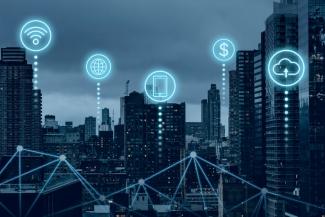Disruptive Technology, Infrastructure and PPPs
What Is Disruptive Technology?
Technological developments have always transformed lives and disrupted old ways of doing things. Older technologies, like the telephone, developed gradually, over decades. In contrast, new technologies, like the cell phone, scale with ever-increasing speed across the global economy. Often a few different new technologies (e.g., artificial intelligence, IoT, 3D printing, robotics) come together to create something entirely new. Although specific types of disruption caused by innovation are difficult to predict with precision, it has already become clear that these new technologies will have significant economic impact and will fundamentally change the way people around the globe work, live, conduct business and interact with each other.
However, not every new technology or innovation is disruptive. The original meaning of disruption is an occurrence of something external from a system, process, or event that prevents it from continuing as usual or as expected. Today, the term disruptive technology (or disruptive innovation) has become a trendy phrase to describe transformative change.1 The phrase is used for technological advancements and innovations that share the following characteristics:
• The technology is rapidly advancing.
• The potential scope of impact is broad.
• Significant economic value could be affected.
• It has the potential to dramatically change the status quo.
The World Bank defines “disruptive and transformative technologies” in its 2019 Development Committee paper2 as those that result in a step change in the access to products and services, and dramatically alter how we gather information, make products, and interact. For the purpose of this report, the terms "disruptive technology" and "disruptive innovation" are used interchangeably and in this broad sense.3
Examples of Disruptive Technologies that Could Transform Infrastructure
Technologies that have the potential to revolutionize or that have already impacted infrastructure projects include the following:4
• Renewable energy
• Stationary and mobile energy storage devices
• Mobile internet (MI)
• Artificial intelligence (AI)
• Mixed reality (MR), virtual reality (VR), and augmented reality (AR)
• Big data
• Blockchain
• Robotics
• Internet of things (IoT)
• 3D printing
• Advanced materials
This list is not meant to be exhaustive, and new technologies that have the potential to significantly affect infrastructure continue to appear. Appendix A provides an overview of these disruptive technologies, with a generic definition of each of these technologies and how they are applied to infrastructure.5 Based on this, How Are Infrastructure PPPs Impacted by Disruptive Technology?, deals with the impact of disruptive technologies on PPP infrastructure projects.
Footnote 1: The concept of disruptive technology (and later disruptive innovation) was originally introduced in 1995 by Clayton M. Christensen, and describes the evolutionary process of a product or service that is initially inferior to what is offered in established markets and only useful to new, emerging markets or smaller, low-end, and often overlooked markets. The product or service then migrates into and dominates the established markets by adapting to deliver the performance and value that the consumers in the established markets demand.
Footnote 2: World Bank Group. 2019. Mainstreaming the Approach to Disruptive and Transformative Technologies at the World Bank Group. See also: World Bank Group. 2018. Disruptive Technologies and the World Bank Group—Creating Opportunities—Mitigating Risks.
Footnote 3: According to the 2017 Organisation for Economic Co-operation and Development (OECD) report Selected Good Practices for Risk Allocation and Mitigation in Infrastructure in APEC Economies, disruptive technology risk is the risk that a new or emerging technology unexpectedly displaces an established technology used in that sector. Such technological changes can cause significant disruption to a project over the term of a concession.
Footnote 4: This is not a comprehensive overview but a selection of technologies that have already or will most likely disrupt infrastructure going forward.
Footnote 5: Appendix B and Appendix C highlight trends related to the application of disruptive technologies in the energy and transport sector.
Subsections




